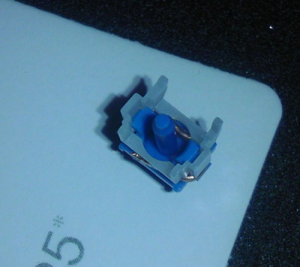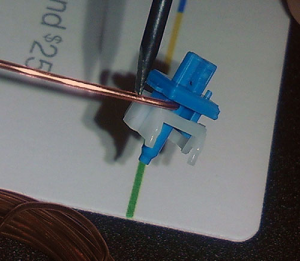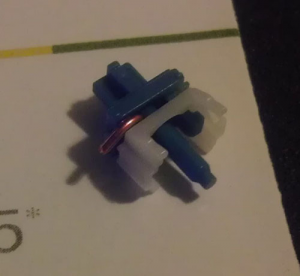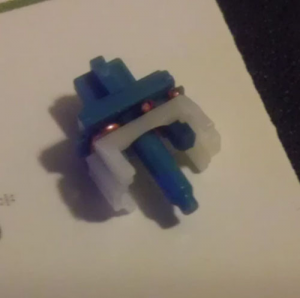In my new member thread I mentioned these and was asked about them. Luckily, I documented the process when I made them (you will have to excuse the lousy cell phone pics).
A while back there was a thread about gluing blues to make them solid, creating "
ghetto browns". I actually decided to try this after some research. First off, I can tell you creates a
very solid click early on, the problem is, this is the ramp engaging, not the switch triggering, which happens just before the switch bottoms out. In fact, if you run o-rings, it comes close to not activating at all as it creates a very long stroke. The secondary (actuation) click is actually far more subtle and as mentioned, almost at the point of bottoming out before it happens and compared to the first click, almost drowned out. Another thing I found was that CA glue (or Superglue) doesn't like ABS and takes quite a while to dry, this isn't really an issue unless you are in a hurry, but I figured it was worth mentioning as it caught me off guard. Personally, I disliked the long travel and the first click was disconcerting.
After brainstorming, I came up with a few methods to lock them down. My first idea was to simply glue them in the down position. While it worked, it was easy to get glue into the wrong places and it wasn't very secure. A good hit or snag and it could probably break loose. The second idea was to try and wrap it with something, thread or wire... Thread would need glue, so I ruled it out right away, tying could work, but that could lead to snags.
Here is a shot of the first two methods. Glued (based on the "ghetto brows" thread, and wire wrapped.

Not only did it take a lot of time to wrap each switch and ensure it wasn't going to hang, of the 5 switches I did it to, almost all had a different feel. 4 hung on actuation and had to be tweaked. This was only the start of my problems. Below is an undershot of the wrapped, and why it had problems. After fixing the snags, I had lots of issues with consistency of feel, what I realized is that while trying to fix the hangups by it sticking out too far, it was being pushed into the spring, and by varying amounts. In some instances, as the spring compressed, it was popping the wire out, giving a very strange and inconsistent feel. Needless to say, I wasn't happy, and promptly ordered some clear switches.

One night while waiting for my clears, I had an epiphany, and this is the result. I call these Jailhouse Blues, because they are locked down blues (locked, like a prison). This new method takes about 30 seconds per switch* to perform and not only is it nearly flawless compared to the other method (only 1 of every 2 dozen needed minor tweaking), it can be undone at any time. *This doesn't count disassembly or assembly time.
So how do they feel...
Combined with blue WASD o-rings, simply put...
Fantastic!
It has a very positive click to it, moreso than browns, but quiet like browns. WhiteFireDragon also says "when it bottoms out, almost all of the noise and shock is taken out". His testing and mine sow the key travels about half as far before actuating (can vary depending on wire used), and it it doesn't "float" like blues do (again, depending on the wire used). Too small of wire can result in some float as the wire doesn't fill the gap enough. Too large can give them a hair trigger.
Tools needed:
Angle cutters, wire, blue switches, and a small flathead.
The wire is beading wire, you can get it in the craft section of Walmart, 4 of these coils (two silver, two copper) for $5. One coil will do a full keyboard. I believe it was 20guage wire.

It will take about 15 seconds per side, 2 switches per minut.
Feed it into the stem alongside the shaft (it takes a bit of pressure), then cut where shown. Make sure it goes all the way through, but does not stick out the other side. The wire inside mostly holds things in place, but you need it to go all the way through so that it doesn't lopside the spring. The part going around the outside is what actually holds the white part in the extended position, and even this doesn't need to be very precise.

Bend it around the outside, and use the screwdriver to press it into the gap. Make sure it doesn't overhang anywhere.

Flip the switch around and repeat. It should look like this when finished. Two "u" shapes, one per side. I don't think it matters if they run opposite, but I did mine that way.

For the astute,
Yes, it does increase the spring pressure because of the wire running over the spring perch. Initially I would have sworn they were similar, but putting them next to my browns, there is a marked increase. This does two things though, it limits the likelihood of hangups, something I've heard Ergo Clears can sometimes do, and the spring helps hold the wire wraps in place with pressure. Odds are they will not move anyhow, but this just ads a little insurance.
Update...
Travel is actually halved, not just reduced a little as I originally stated. WhiteFireDragon also says they are much more quiet when bottoming out, a bonus for those who dislike the noise. Also, consensus now is that it raises the spring rate quite bit more than I thought as well. Something more akin to a Black spring according to him.
Update 2...
Revised a bit, and I have plans to reduce spring pressure.
Update 3...
I cut the springs to bring pressures down, and they are AWESOME! I got my clear switches in, and plan to return to these as they feel just like short travel Ergo Clears.
I did some measurements using nickels to get actuation force.
Stock was 40-45 grams.
JB's were up around 80 grams(!)
I started cutting the spring and re-measuring:
JB's with 3 flat coils cut off 55-60 (closer to 60)
JB's with 3 flat coils and one normal cut off 50-55 (closer to 50)
JB's with 3 flat coils and two normal cut off 40-45
Note that lube lowers another 5grams and the closer you get to 40grams, if things aren't perfect, they can stick due to the tactile bump being so pronounced. Mine all worked great at 80 (of course) but when I reached 45, my R and M needed a slight touch up to keep from sticking on occasion. I cut mine down to 3 flat coils, plus 1 normal coil, and then lubed them. If you cut them, you want the cut end down in the switch itself as it has a thick post that will keep it aligned better than up top.